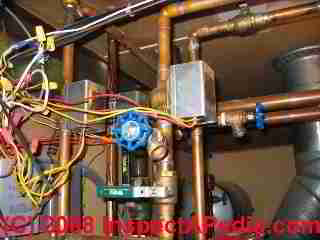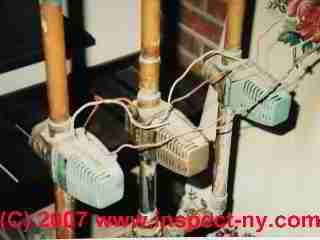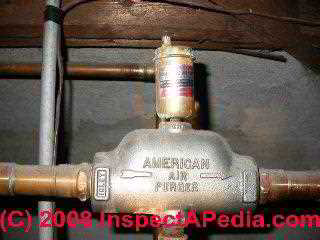 Dissolved Oxygen Damage to HVAC Equipment
Dissolved Oxygen Damage to HVAC Equipment
Cause & Prevention of hydronic or HVAC system damage by dissolved oxygen
- POST a QUESTION or COMMENT about dissolved oxyten in hyronic heating system water
Dissolved Oxygen problems in hydronic heating systemsd:
What is a zone valve, how do they work.
How do I choose & install a zone valve, how do I wire up a zone valve, and how do I troubleshoot, repair or replace a zone valve?
This article series answers most questions about Heating System Boiler Controls on central heating systems to aid in troubleshooting, inspection, diagnosis, and repairs.
The photo above shows a few zone valves controlling heat distribution in U.S. home. Some manufacturers such as Honeywell specifically warn against using some zone valves on heating systems where a significant level of dissolved oxygen is likely to be present.
InspectAPedia tolerates no conflicts of interest. We have no relationship with advertisers, products, or services discussed at this website.
- Daniel Friedman, Publisher/Editor/Author - See WHO ARE WE?
Dissolved Oxygen in Heating Boiler Water: Problems / Remedies

Watch out: Hydronic heating system (hot water) heating boiler zone valves, pipes, controls, or the boiler itself may suffer a reduced life or damage from signifcant levels of oxygen dissolved in the heating system's water.
Several corrosive effects may be present, including highly-corrosive water, improper pH, and heating system water with a high oxygen content.
Question: are there zone valves that resist damage from dissolved oxygen in hydronic heating system boiler water
Denys Picard said:
Honeywell warns that makeup water feed to a boiler may damage the rubber plug of Zone Valves 8043 and make them fail.
Are they zone valves resistant to dissolved oxygen from makeup water feed? Thank you. - question and reply posted originally
Reply:
Thank you for a great question, Denys. In the Honeywell company's product literature for some products we read:
Suitable for glycol/water mix up to 50:50 use in closed hydronic systems. Not for use with oxygenated water, potable water or steam.
Use this valve in hydronic systems which do not contain dissolved oxygen in the system water. The dissolved oxygen, which is found in systems that have a frequent source of make-up water, causes the rubber plug inside the valve to deteriorate and eventually fail. - sources given below.
I have had trouble finding residential-grade zone valves that specifically claim extra resistance to dissolved oxygen in the heating water [I'm still researching that option].
But beyond warnings supporting your concern, I also found a different viewpoint arguing that in an intact (not leaky) closed residential hydronic heating system, the dissolved oxygen in the initial water fill is not likely to be enough to raise a corrosion problem. So why the warnings?
I speculate that warnings from Honeywell, Taco, and other manufacturers of heating equipment are based on a more-practical observation that over the life of a typical residential hydronic heating system both corrosive water or system water and air leaks are common enough that dissolved-oxygen-related parts corrosion can lead to failures of zone valves or other components.
We report here on the common measures recommended to avoid heating equipment or control or piping damage from dissolved oxygen.
Dissolved Oxygen Hazards for Hydronic Heating Systems
The chief oxygen corrosion hazard for residential zone valves would be in using this zone valve on a hot water heating loop supplied from a steam boiler - perhaps for heating a basement or lower building floor when other areas are heated by steam. Because steam boilers continually require makeup water the water chemistry is a concern for the zone valve as well as for other parts.
A straight 100% hydronic (all hot water) heating system is not normally taking in makeup water; even so, some experts note that both dissolved oxygen and low pH in these systems are principal causes of component corrosion. - www.gewater.com/handbook/boiler_water_systems/ch_11_preboiler.jsp That source suggests (and discusses the pros/cons of ) using a deaerator or an economizer to reduce the dissolved oxygen level if your system is suffering from that problem.
That's from a (in my OPINION) rather reputable source that I've cited before, GE Power Water & Process Technologies, a division of General Electric, that sells water treatment equipment (perhaps of particular concern for large commercial plants or power generating plants).
We researched oxygen related corrosion in residential hydronic or hot water heating systems, finding that the presence of legionella bacteria was cited more often than corrosion concerns for the water in these systems.
If you are eliminating air from your system properly you are probably reducing the dissolved-oxygen-related risk for residential hydronic heating systems. (Cotton 2013).
In my OPINION was supported by Larsen's work back in 1975: if your closed-system hot water (hydronic) residential home heating boiler is not suffering from recurrent air problems, oxygen corrosion should not be a significant worry.
Here is an Except from Larsen on oxygen dissolved in home heating system water:
Were water of this same oxygen concentration [as distributed in a municipal water supply, up to 14 mg/l] used in a home hot-water heating system largely composed of steel with no replenishment or replacement of the water, the system would last indefinitely, because the limited supply of oxygen would be quickly removed, and little or no corrosion would then be possible.
Watch out: the final authority about the requirement to avoid dissolved-oxygen damage is the manufacturer, such as Honeywell if you are using a Honeywell product. For certain products the company specifically warns "not for use in systems containing dissolved oxygen". Examples include:
- Honeywell two-way Fan Coil Valve - includes a specific warning against dissolved oxygen
- Honeywell V8043A,E,F 5000 Series ZONE VALVES [PDF] - includes a specific warning against dissolved oxygen
- HONEYWELL V8043D ZONE VALVE INSTRUCTIONS [PDF] - includes a specific warning against dissolved oxygen
You should call the manufacturer to ask if your specific system set-up is a concern or not. If you don't have it, contact information for Honeywell is at HONEYWELL CONTROLS.
Larsen's study concludes with this warning worth noting, while keeping in mind that here the focus was not specifically on heating boilers:
The determination of the depletion of dissolved oxygen throughout this system is not a true measurement of the degree of corrosion.
Depletion of dissolved oxygen at the “dead” ends and service lines of the [public water distribution] system gives rise to a condition where ferrous iron is not oxidized to insoluble ferric oxide and solution of iron to the ferrous state takes place at the expense of the nitrite and nitrate previously formed—quite possibly by bacterial action.
What corrosion that does take place in the system as a whole is magnified by the accumulation of traces of the iron in the gelatinous masses of bacterial growths clinging to the pipe in localities where the velocity of flow is low and sloughing off occasionally.
Methods for Avoiding Dissolved Oxygen Damage to HVAC Equipment, Piping Controls
- Proper piping installation details should be taken to avoid air leakage into the heating system piping or boiler.
An example is a defective automatic air bleeder valve that leaks water out and, at high locations, may draw air into the piping system each time the system pressure drops (when the boiler is off).
Leaks at valves, controls, bad connections, or in heating distribution piping in both conventional hydronic heating systems (baseboard heat, radiators, convectors) as well as in radiant heating systems in floors and ceilings can admit air into the system. - Automatically remove air from the heating system using air bleeder valves or air vents - details are at AIR BLEEDER VALVES
- Corrosion-Resistant Heating Controls & Valves: you'll find that at least some HVAC controls rated for commercial use drop the "avoid dissolved oxygen" warning.
- Install a bulk air removal device (standard on most hydronic heating systems) like the Taco cast-iron air scoop that separates air bubbles (not dissolved oxygen) and vents them through an attached float-type air vent.
Details are at AIR SCOOPS PURGERS SEPARATORS - Use a heating boiler water corrosion inhibitor recommended by the boiler or control manufacturer.
See CHEMICAL TREATMENTS, BOILER - Heating system piping: water leaks out of pipes mean that in circumstances there can also be air leaks-in. We've seen air leaks in to hot water heating systems at circulator pump mount flanges and air bleeders as well as at leaky corroded pipe fittings.
Types of copper pipe and the copper used on heating system are described at COPPER PIPING in BUILDINGS.
If using plastic tubing for handling the system water, use tubing that meets the DIN 4726 Standard. See PEX PIPING INFORMATION
Watch out: for new hydronic heating installation piping if you are using plastic piping such as PEX, do not use non-oxygen-barrier PEX tubing.
Non-barrier PEX tubing is blue in color, oxygen barrier PEX is bright red and includes an external layer of EVOH polymer (glossy) meeting Standard DIN 4726 for oxygen permeability in order to be considered suitable for closed-loop hot water (hydronic) heating systems, radiant floor heating systems, and snow melting systems. - Heating system maintenance: signs such as gurgling in the heating water lines are a sure indicator that there is an air problem in the system and probably a leak.
Watch out: Don't ignore those warnings as before your zone valve or pipes are corroded from dissolved oxygen the heating system will probably stop working from being air-bound. See AIR-BOUND HEATING SYSTEMS for details. - Inspect heating system piping & controls for leaks or corrosion on metal piping, joints, connections, devices. See LEAK INSPECTION of WATER SYSTEMS for examples of copper pipe leaks traced to corrosive water. Water leaks out also permit air leaks into the system.
Research on HVAC Equipment or Control Damage from Oxygen Dissolved in System Water Supply
- AIR ELIMINATION from HYDRONIC HEATING SYSTEMS [PDF], TACO, INC., 1160 Cranston Street, Cranston, RI 02920 USA Tel: (401) 942-8000, or TACO (Canada), Ltd., 6180 Ordan Drive, Mississauga, Ontario L5T 2B3 Canada, Tel: 905/564-9422, retrieved 2017/07/15, original source https://www.taco-hvac.com/uploads/FileLibrary/AirElimination.pdf
- Cotton, J. B., and W. R. Jacob. "Prevention of corrosion in domestic hot water central heating systems." British Corrosion Journal 6, no. 1 (1971): 42-44.
Abstract: The corrosion reactions that are likely to occur when bare steel is exposed to water in domestic central heating systems are discussed and the resultant effects are related to corrosion of radiators per se, and to the ancillary occurrence of hydrogen gas-locking in. radiators and to blockage of pumps by loose magnetite. - LEAK CAUSES in WATER PIPING [Web article]
- Larson, Thurston Eric. "CORROSION by DOMESTIC WATERS" [PDF] Bulletin (Illinois State Water Survey) no. 59 (1975) State of Illinois Department of Registration and Education, Illinois State Water Survey, Urbana 1975,
Abstract:
Essential data on corrosion gathered by the Illinois State Water Survey in isolated or programmed studies, and from experience at state institutions since 1950, are summarized. A brief review of basic fundamentals of corrosion is presented as background for the summaries.
Also included are some of the general and specific recommendations concerning inhibitors and construction materials that were developed through laboratory and field evaluations for use by architects, engineers, and institutional maintenance personnel.
Appendixes contain a discussion of corrosion in water wells and pumps and two ancillary papers for orientation and recognition of other factors related to distribution system water quality. - Von Fraunhofer, J. A. "Corrosion in hot water central heating." British Corrosion Journal 6, no. 1 (1971): 23-30.
Abstract: The basic principles of corrosion relevant to wet central heating are reviewed. The corrosion phenomena of hydrogen evolution, magnetite formation and radiator perforation are considered in the light of theory and practice. Current and future research work in this field at the Gas Council, Watson House, is outlined. - Zacheus, Outi M., and Pertti J. Martikainen. "Occurrence of legionellae in hot water distribution systems of Finnish apartment buildings." Canadian Journal of Microbiology 40, no. 12 (1994): 993-999.
...
Continue reading at ZONE VALVES, HEATING or select a topic from the closely-related articles below, or see the complete ARTICLE INDEX.
Or see these
Recommended Articles
Suggested citation for this web page
DISSOLVED OXYGEN DAMAGE CONTROL at InspectApedia.com - online encyclopedia of building & environmental inspection, testing, diagnosis, repair, & problem prevention advice.
Or see this
INDEX to RELATED ARTICLES: ARTICLE INDEX to HEATING SYSTEMS
Or use the SEARCH BOX found below to Ask a Question or Search InspectApedia
Ask a Question or Search InspectApedia
Try the search box just below, or if you prefer, post a question or comment in the Comments box below and we will respond promptly.
Search the InspectApedia website
Note: appearance of your Comment below may be delayed: if your comment contains an image, photograph, web link, or text that looks to the software as if it might be a web link, your posting will appear after it has been approved by a moderator. Apologies for the delay.
Only one image can be added per comment but you can post as many comments, and therefore images, as you like.
You will not receive a notification when a response to your question has been posted.
Please bookmark this page to make it easy for you to check back for our response.
IF above you see "Comment Form is loading comments..." then COMMENT BOX - countable.ca / bawkbox.com IS NOT WORKING.
In any case you are welcome to send an email directly to us at InspectApedia.com at editor@inspectApedia.com
We'll reply to you directly. Please help us help you by noting, in your email, the URL of the InspectApedia page where you wanted to comment.
Citations & References
In addition to any citations in the article above, a full list is available on request.
- Honeywell V8043D zone valve [PDF installation instructions], Honeywell Corporation, 2985 Douglas Drive North, Golden Valley MN 55433, retrieved 2/3/14 original source: https://customer.honeywell.com/resources/techlit/ TechLitDocuments/95c-00000s/95C-10938B.pdf
- Our recommended books about building & mechanical systems design, inspection, problem diagnosis, and repair, and about indoor environment and IAQ testing, diagnosis, and cleanup are at the InspectAPedia Bookstore. Also see our Book Reviews - InspectAPedia.
- Fuel Oil & Oil Heating Magazine, 3621 Hill Rd., Parsippany, NJ 07054, 973-331-9545
- In addition to citations & references found in this article, see the research citations given at the end of the related articles found at our suggested
CONTINUE READING or RECOMMENDED ARTICLES.
- Carson, Dunlop & Associates Ltd., 120 Carlton Street Suite 407, Toronto ON M5A 4K2. Tel: (416) 964-9415 1-800-268-7070 Email: info@carsondunlop.com. Alan Carson is a past president of ASHI, the American Society of Home Inspectors.
Thanks to Alan Carson and Bob Dunlop, for permission for InspectAPedia to use text excerpts from The HOME REFERENCE BOOK - the Encyclopedia of Homes and to use illustrations from The ILLUSTRATED HOME .
Carson Dunlop Associates provides extensive home inspection education and report writing material. In gratitude we provide links to tsome Carson Dunlop Associates products and services.


